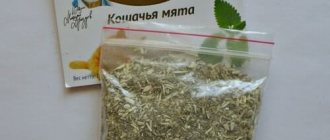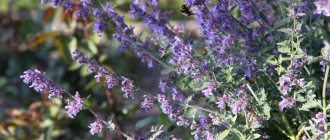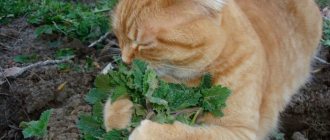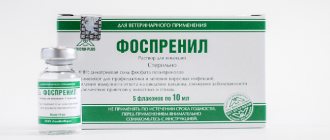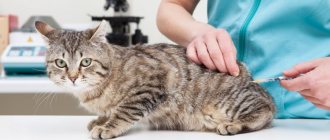Catnip is a low-growing plant that has a spicy aroma. This smell is very attractive to cats. The second name of the plant is lemon catnip or budra. Previously, in Egypt it was used as bait for cats, including their relatives such as panthers and leopards.
Despite the fact that the plant causes a strong emotional reaction in animals, it is absolutely harmless to them and is even used for medicinal purposes.
Description of the plant
Lemon catnip grows in Central, Eastern and Western Europe, East Asia, western Siberia and the Caucasus.
In appearance, the plant is almost no different from ordinary mint. But catnip contains nepetalactone, and peppermint contains menthol. It is for this reason that these plants have different smells. The aroma of catnip contains lemon notes.
The leaves of the plant are light green in the shape of a heart, sometimes they may contain splashes of white or pink. The flowers are small, collected in a brush. They can be white, pink or purple. Catnip stems are long. They spread along the ground and intertwine with each other, forming dense thickets. Today there are about 200 species of this plant.
Cats love to spend time in catnip thickets. As a rule, in such places you can see more than a dozen animals at once. Catnip exudes an aroma that has an effect on them similar to that of valerian. Animals seem to fall into euphoria. At the same time, they can behave very strangely.
Catnip – photo
It is impossible to cover all the diversity of catnip species in one material. Compact dwarf bushes, tall large-flowered varieties - all this is a fragrant, spectacular catnip. Just look!
Photo: alexsad.ru
Photo: alexsad.ru
Photo: balance-fit.ru
Photo: na-dache.pro
Photo: garden.org
Photo: gornyjvozduh.ru
Photo: agro-ra.ru
Photo: sadovnote.ru
Photo: dacha-review.ru
Photo: yesofcorsa.com
Photo: ersentt23.blogspot.com
Photo: news.shajtanshop.com
Photo: na-dache.pro
Photo: letsgoplanting.co.uk
Photo: bg.lybadvice.com
Photo: gardenersdream.co.uk
Photo: ru.designideashome.com
Photo: rockydale.wordpress.com
Photo: baumschule-horstmann.de
Photo: sadovaya24.ru
Photo: terranovanurseries.com
Photo: shnyagi.net
Photo: lyudmila-klyopova.tourister.ru
Photo: lv.sciencedc.com
Did you like the post? Subscribe to our channel in Yandex.Zen, it really helps us in our development!
The principle of influencing a cat
When an animal inhales the aroma of a plant, essential oils enter its respiratory tract. From there the signal goes to the hypothalamus of the brain. The cat experiences short-term hallucinations, and as a result, strange behavior. The animal begins to roll on the floor, purr, jump, lick, and play. This is similar to the behavior of a kitten.
The effect lasts 10-15 minutes, after which the cat calms down and may fall asleep. This continues for about half an hour. The reaction may then repeat. If a cat tastes catnip, the effect may be the opposite.
The plant affects animals in different ways. A lethargic cat can become playful. And if the animal is very active, it is likely that under the influence of catnip, it will become passive. This should not be a concern for owners. The animal has an intuition that tells it when to stop sniffing or chewing the plant.
Important! Catnip contains no drugs and is not addictive.
Main characteristics
Due to the specific smell, not all gardeners would like to see this representative of the flora on their site. In addition, in the absence of sufficient snow cover in winter, the catnip may freeze to death. In addition, the plant is not a perennial and to continue the growing season it must be replanted regularly (about once every three to five years). However, not all types of catnip have an unpleasant aroma, but there are quite nice specimens with a palette of blue shades, rare for garden flowers. On the contrary, some lovers use catnip in herbal teas and add them to various homemade preparations.
Catnip actually has a number of medicinal properties. It contains a large amount of vitamin C, which means herbal preparations that contain catnip have an immune-strengthening effect. Catnip also helps with cough, fever, stomach ulcers, lack of appetite, and has a sedative effect. And if you add it to your bath, you can relieve the symptoms of some skin diseases.
The advantages of catnip also include the fact that it can be safely planted where there are children; it is not at all poisonous. This plant is also an excellent honey plant and can attract bees to your site.
How to use catnip
Some owners believe that catnip has a negative effect on the pet's nervous system. This is a misconception. On the contrary, using catnip will help get rid of many problems, incl. psychological. Catnip can be used in situations where:
- the pet has an aggressive character - just give him a little dried catnip.
- the cat is very playful and is capable of turning everything upside down in the house, the plant will have a calming effect on him;
- It is necessary to accustom the animal to the tray - you should put a little dry catnip under the container. The smell will attract the cat's attention, and the learning process will be faster and easier;
- the owner is going on a trip with the pet, or is planning a trip to the veterinary clinic - we recommend putting a few sprigs of catnip in the carrying bag, this will help relieve stress in the animal;
- the cat has recently arrived in the house and needs to get used to its new housing, it is recommended to place branches of the plant in the area of its sleeping place;
- the animal is passive and lethargic - a little catnip placed in toys will cheer it up;
- your pet has a stomach spasm - the bactericidal properties of catnip will help solve the problem;
- the animal refuses to eat - catnip will increase appetite;
- the cat sharpens its claws on the furniture and ignores the scratching post - you should carefully open the covering of the scratching post, place plant branches inside it and sew it up. The animal will smell the mint and leave the furniture alone. This is one of the most effective ways to train a dog to use a scratching post.
Attention! Catnip is indicated for cats infected with helminthic infestation. The plant prevents the proliferation of helminths.
Catnip can be used both fresh and dried. When stored, the plant retains all its properties.
Preparation of medicinal raw materials
Fresh and dried leaves, flowers and stems can be used to prepare tea, decoctions, infusions, and as a seasoning for various dishes. The collection of raw materials is carried out during the flowering period. After the fruits begin to form, the concentration of nutrients decreases sharply. It is best if the plant is grown by you yourself in your own summer cottage or garden plot. Harvesting of wild herbs is carried out away from busy highways and industrial enterprises.
The green mass is cut early in the morning, in dry weather, at a height of 8-10 cm from the soil surface. The stems are carefully tied into small bunches and hung to dry under a shed, in the attic or in another well-ventilated area, so that they are not exposed to direct sunlight.
Dried catnip can be left hanging for storage, providing protection from dust and moisture. You can carefully crush (cut) and package in linen or paper bags (bags), scatter in glass jars. Periodically you need to check the condition of the prepared raw materials. If signs of mold appear, it is necessary to spread it in a thin layer in a drying room or dry it in the oven. When properly stored, raw materials do not lose their beneficial qualities for 2 years.
Contraindications
Cats are naturally endowed with the ability to recognize which grass they can take and in what quantity. However, the owner is responsible for the pet. Therefore, you should not rely on the animal’s intuition if:
- the cat is pregnant;
- the pet reacts too violently to the action of catnip. In this case, excessive consumption of grass can deplete the animal's nervous system. A violent reaction should be understood as agitated behavior of the cat for more than half an hour with excessive physical activity.
In these cases, you should limit your pet's access to catnip. There are no other contraindications to taking catnip. But, if there are several cats in one house, and among them there is a male, it must be taken into account that under the influence of the plant he can become aggressive. Therefore, cats can only be given catnip separately from cats.
Pest and disease control
Catnip does not get sick too often due to the plant’s good immunity. In dry, hot summers it is affected by powdery mildew. Then it’s worth picking off all damaged leaves and treating the planting with fungicides. Mites and whiteflies appear less frequently, but complex preparations are also sufficient here.
In addition, very real and significant damage can be caused by cats attracted by the smell. That is why it makes sense to plant catnip separately and away from valuable crops.
Photo: zen.yandex.ru
Daisies (50 photos): types, planting and care in open ground
Why doesn't my cat react to catnip?
The effects of catnip do not apply to all cats. A specific gene in the animal’s body, which may or may not be present, is responsible for susceptibility to the plant. This is typical for every third individual.
Kittens that have not reached sexual maturity also do not react to catnip. But they don't need it. Kittens are already very playful. Before 6 months there is no point in giving them catnip.
An animal may not respond to catnip under severe stress. Therefore, if there is a situation ahead that can significantly affect the emotional state of the pet, it is recommended to treat it with catnip in advance so that it has time to relax.
The animal's immunity may also be explained by the low content of essential oil in the plant. Usually it contains up to 3%, but this figure may decrease if the plant does not have enough light.
Bush propagation
This fragrant, unpretentious bush can grow on its own, like a weed. In order for the plot to have a neat appearance and grow in the place where the gardener needs it, you need to monitor its growth and remove unnecessary sprouts.
The best time for these manipulations will be autumn. The plant to be divided must have at least three stems. Growing catnip is a great pleasure for beginners who love gardening beauty and benefits.
How to grow catnip in a pot - step by step instructions
In nature, catnip can be found in forests, bushes, meadows, fields, vegetable gardens, along river banks and near roads. To be able to pamper your pet at home, you can grow the plant indoors in a pot. Please note that catnip loves warmth, moisture and light. A lack of these components can negatively affect the performance of the plant.
Catnip can be grown from seeds, which are sold at any pet store. But it’s better to take a cutting or a rooted shoot, which can be found right on the street. The cutting should be placed in a glass of water, where it should remain until roots appear. When choosing a pot, you need to give preference to a medium-sized container.
The plant is recommended to be planted in early autumn. Then you should follow the following sequence of actions:
- Pour drainage into the pot.
- Fill the container halfway with soil, which should be pre-moistened.
- Plant seeds or seedlings in the ground.
- Cover the pot with film, creating greenhouse conditions.
- Place the container in a lighted place.
After two weeks, sprouts should appear. When the first leaves form, the plant should be fed. It is necessary to select the strongest shoots and clear space for their growth. The stems need to be secured with wire. About 2.5 months after planting, with proper care, catnip should bloom.
Attention! The pot with the plant must be placed in a place inaccessible to the cat. Otherwise, the animal will damage the sprouts and the catnip will die.
Catnip should be re-fertilized in February, when daylight hours increase and the plant begins to actively grow. It is necessary to ensure that the catnip has enough light. Otherwise, the amount of essential oils in the leaves will decrease.
In summer, catnip should not be kept in direct sunlight to prevent the soil from drying out. The plant loves moisture, so there should always be water in the pan.
Watering
When planting catnip, the plant needs to be watered abundantly and regularly until it gets stronger. The average schedule includes 1-2 waterings per week. This principle should be followed for several weeks. During its adult vegetative stage, catnip only needs watering on very dry days.
Attention. The plant is a honey plant. When planning a planting site, you need to consider the proximity to bees.


